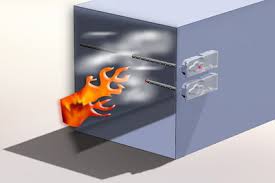
The mechanical codes cover both flexible air ducts and flexible air connectors. They are similar in appearance, but they are not the same.
A flexible air duct conveys air in an HVAC duct system. A flexible air duct typically connects a main trunk to an air inlet or outlet. The mechanical code does not limit their length. However, design requirements typically limit the length of flexible air ducts to six feet. This limitation avoids high-pressure drops and kinking in long sections of flexible air ducts.
A flexible air connector is designed to connect different duct system components, e.g., connecting equipment to ductwork. Flexible air connectors are meant to absorb vibrations or slight misalignments and are limited in length to 14 feet.
The “flexible air ducts” listing label is rectangular and states “Listed Air Duct.” The listing label on “flexible air connectors” is circular in shape and states, “Listed Air Connector.” Both are listed to UL 181 Class 0 or Class 1 requirements.
International Mechanical Code (IMC) Requirements, 2024 edition
Definitions
FLEXIBLE AIR CONNECTOR. A conduit for transferring air between an air duct or plenum and an air terminal unit or between an air duct or plenum and an air inlet or air outlet. Such conduit is limited in its use, length, and location
Chapter 6: Duct Systems
Section 603: Duct construction and installation
603.6: Flexible air ducts and flexible air connectors
603.6.1: Flexible air ducts.
Flexible air ducts, both metallic and nonmetallic, shall be tested in accordance with UL181. Such ducts shall be listed and labeled as Class 0 or Class 1 flexible air ducts and shall be installed in accordance with Section 304.1.
603.6.1.1: Duct length
Flexible air ducts shall not be limited in length.
603.6.2: Flexible air connectors.
Flexible air connectors, both metallic and nonmetallic, shall be tested in accordance with UL181. Such connectors shall be listed and labeled as Class 0 or Class 1 flexible air connectors and shall be installed in accordance with Section 304.1.
603.6.2.1: Connector length.
Flexible air connectors shall be limited in length to 14 feet.
603.6.2.2: Connector penetration limitations.
Flexible air connectors shall not pass through any wall, floor, or ceiling.
603.6.3: Air temperature.
The design temperature of air to be conveyed in flexible air ducts and flexible air connectors shall be less than 2500F.
603.6.4: Flexible air duct and air connector clearance.
Flexible air ducts and air connectors shall be installed with a minimum clearance to an appliance as specified in the appliance manufacturer’s installation instructions.
Section 607: Duct and transfer openings.
607.7: Flexible ducts and air connectors.
Flexible ducts and air connectors shall not pass through any fire-resistance-rated assembly.
Chapter 3: General Regulations
Section 304: Installation
304.1: General
Equipment and appliances shall be installed as required by the terms of their approval, in accordance with the conditions of the listing, the manufacturer’s installation instructions, and this code. Manufacturer’s installation instructions shall be available on the job site at the time of inspection.

